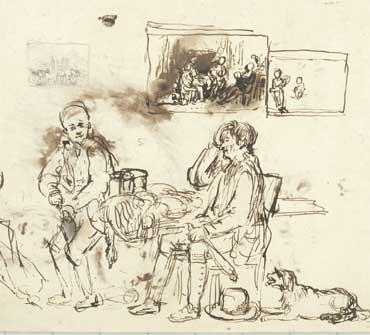On 1 Jul, 2010 With
Palomino says that when Titian’s famous painting of the Last Supper arrived at the Escurial, it was found too large to fit the panel in the refectory, where it was designed to hang. The king, Philip II., proposed to cut it to the proper size. El Mudo (the dumb painter), who was present, to prevent the mutilation of so capital a work, made earnest signs of intercession with the king, to be permitted to copy it, offering to do it in the space of six months. The king expressed some hesitation, on account of the length of time required for the work, and was proceeding to put his design in execution, when El Mudo repeated his supplications in behalf of…
Read More
On 30 Jun, 2010 With
To be resolved: continuing Bridgewater loan and sale of second painting By Martin Bailey The Art Newspaper Fundraising for Titian’s Diana and Actaeon has been successful, but concluding the £50m deal with the Duke of Sutherland has become bogged down over legal and financial questions. The original deadline for the National Gallery of Scotland (NGS) and the National Gallery (NG) in London to sign a firm commitment to buy was 31 December. Both the Duke and the galleries are becoming increasingly frustrated by the delay. The Art Newspaper can reveal that there have been two difficult issues to resolve. The first concerns assurances over the continued loan of the remaining 26 Bridgewater paintings that have hung at the NGS since…
Read More
On 30 Jun, 2010 With
10 intriguing facts and trivia about the great artist, Leonardo da Vinci. By Marion Boddy-Evans, About.com I had great fun working my way through the book Da Vinci for Dummies (Buy Direct) and thought I’d share some of the intriguing things I’d learned about him. The kind of things that come up in trivia quizzes or to drop into conservations at a dinner table. Leonardo da Vinci Fact No 1: Not a Prolific Painter Leonardo left fewer than 30 paintings, and these aren’t even all finished. But before you think you can do the same and still go down in art history, remember he also left hundreds of drawings, sketches, and pages of notes. His reputation isn’t just based on his paintings. Leonardo…
Read More
On 30 Jun, 2010 With
The drawing may be original or may be a print of a Sargent “Mug” which is then inscribed by Ethel Barrymore which she may have given out to close friends. Another drawing — original I assume — has turned up at Adelson Galleries — see below. There is obviously a difference between the two. It appears that Sargent did more than one drawing — this one above being the main one. However my feeling is that Ethel wouldn’t have signed an original — I mean she might have been vain but that’s pretty extreme, and I’m finding other instances where the sitter had prints made of Sargent’s “Mug” drawing which they then gave out to close intimates. That may be…
Read More
On 30 Jun, 2010 With
New discoveries in America’s oldest public collection of drawings Works by John Singer Sargent and David Wilkie are among the finds By Jason Edward Kaufman NEW YORK. The first scholarly survey of the drawings collection of the New York Historical Society has brought to light previously unknown or misattributed works by John Singer Sargent, Louis Comfort Tiffany, David Wilkie and others. The 8,500 works, most of which are by American artists, constitute the earliest assembled public drawing collection in the United States, begun in 1816, but they had never been systematically studied until curator Roberta Olson began the task five years ago. Nearly 200 highlights of her study, which was funded in part with a $175,000 grant from the Getty…
Read More
On 30 Jun, 2010 With
Some museums have lined up to authenticate “amazing” find of lifetime plaster casts, but the leading experts refuse to comment By Martin Bailey A secret battle is being waged over a previously unknown group of plasters of all Degas’ known sculptures that—if proved to be genuine—would represent one of this century’s greatest art discoveries. The cache was unveiled by dealer and sculpture specialist Walter Maibaum, who runs the New York-based Modernism Fine Arts, in Athens on 27 November. But so far, the discovery has received little critical analysis, despite widespread press coverage heralding the find. Behind the scenes, the experts are divided: some believe the plasters to be previously unknown lifetime casts, bringing us closer to Degas’ original sculptures. Others…
Read More
On 29 Jun, 2010 With
A look at the colours the Old Master Leonardo da Vinci used in his paintings. By Marion Boddy-Evans, About.com We may never know who the Mona Lisa was or what she’s smiling about, but we do have some idea of how Leonardo da Vinci created the sombre mood and smoky colors that add to her allure. Leonardo would first create a detailed underpainting in a neutral gray or brown, then apply his colors in transparent glazes on top. Some of the underpainting would show through the layers, subtly helping to create form. On his palette were muted, earthy browns, greens, and blues within a narrow tonal range. This helped give a sense of unity to the elements in the painting. No intense colors…
Read More
On 28 Jun, 2010 With
Belgian artist Luc Tuymans talks to us on the eve of exhibitions in Europe, Russia and the US By Gareth Harris Luc Tuymans has painted figurative works since the mid 1980s and few artists can be as closely identified with a particular palette. His taste for mouldy pastels, cool greys and dead plaster white make for blurred, obtuse images. This reductive colour scheme represents the elusive nature of history and memory, reflecting the artist’s belief that representation can only be partial and subjective. Loaded political themes are developed in seemingly tangential ways with the Holocaust, Belgium’s controversial role in post-colonial Congo (the influential “Mwana Kitoko: Beautiful White Man” series which was shown at the 2001 Venice Biennale) and the US…
Read More
On 26 Jun, 2010 With
Fuseli early gained a reputation for scholarship, poetry, and painting. He possessed such extraordinary powers of memory, that when he read a book once, he thoroughly comprehended its contents; and he not only wrote in Latin and Greek, but spoke them with the fluency of his native tongue. He acquired such a perfect knowledge of the several modern languages of Europe, especially of the English, French, and Italian, that it was indifferent to him which he spoke or wrote, except that when he wished to express himself with most power, he said he preferred the German. After having obtained the degree of Master of Arts from the college at Zurich, Fuseli bade farewell to his father’s house, and traveled in…
Read More
On 25 Jun, 2010 With
He early manifested strong powers of mind, and with a two-fold taste for literature and art, he was placed in Humanity College at Zurich, of which two distinguished men, Bodmer and Breitenger, were professors. Here he became the bosom companion of that amiable enthusiast, Lavater, studied English, and conceived such a love for the works of Shakspeare, that he translated Macbeth into German. The writings of Wieland and Klopstock influenced his youthful fancy, and from Shakspeare he extended his affection to the chief masters in English literature. His love of poetry was natural, not affected—he practiced at an early age the art which he admired through life, and some of his first attempts at composition were pieces in his native…
Read More



